Text
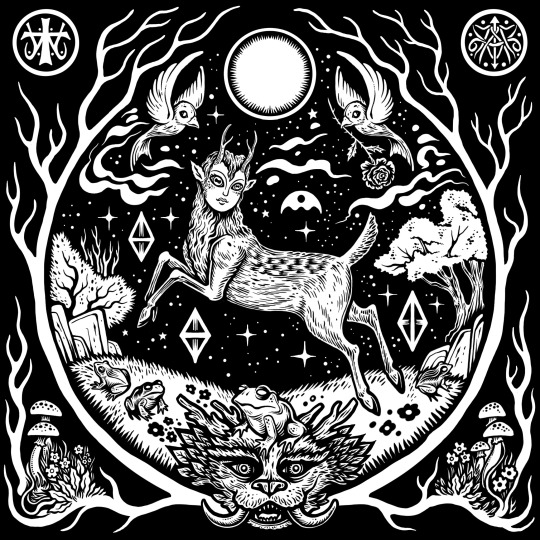
🌕𒆜քɨռӄ ʍօօռ 𒆜🌕
Charge your crystals and make some Moon Water under Aprils’s full moon in Libra ♎️ tonight. The pink moon is a nod to the bountiful blooming flowers and trees that the spring weather brings. In particular, the pink moon gets its name from a hot pink wildflower, Phlox subulata, that grows in a thick mat of vibrant foliage, commonly referred to as creeping phlox, moss phlox or moss pink. The Pink Moon is also known as the Frog Moon 🐸
#illustration#lore#witchcraft#witch#folklore#magick#artists on tumblr#chaos magick#wiccan#full moon#april full moon#pink moon#frog moon
24 notes
·
View notes
Text

🌸💀PΞЯSΞPHФИΞ💀🌸
Celebrating Ostara and the Spring Equinox with Persephone, the Maiden, Goddess of Spring and Nature and Queen of the Underworld.
Kore, Bringer of Fruit, Aristi Cthonia.
#ostara#ostarablessing#eostre#ishtar#spring#spring equinox#persephone#proserpina#goddess of spring#queen of the underworld#witch#witchcraft#hecate#magick#chaos magick#sigil magick
34 notes
·
View notes
Text

• ⱠɄ₱ɆⱤ₵₳Ⱡł₳ •
Fuck Valentine’s day and the Church, celebrate Lupercalia and praise Fauno Luperco! 🐺🐺🐺
#witchcraft#folklore#witch#lore#magick#artists on tumblr#vasco brighi illustration#wiccan#lupercalia
19 notes
·
View notes
Text

𒆜ɮʀɨɢɨɖ’ֆ ƈʀօֆֆ 𒆜
𝗜𝗺𝗯𝗼𝗹𝗰 𝗖𝗲𝗹𝗲𝗯𝗿𝗮𝘁𝗶𝗼𝗻
Let go the snow, welcome the sun
#imbolc#witchcraft#folklore#witch#magick#artists on tumblr#wiccan#lore#brigid#brigid’s cross#celtic#myth#mythological#occult art#winter#aquarius
13 notes
·
View notes
Photo
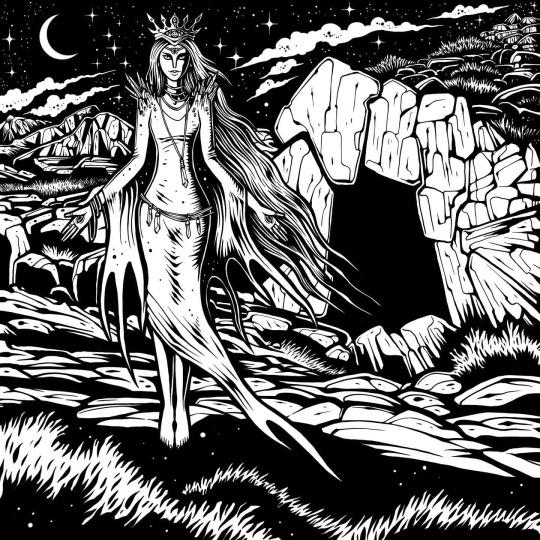
🝍 𝕴𝖙𝖆𝖑𝖎𝖆𝖓 𝕱𝖔𝖑𝖐𝖑𝖔𝖗𝖊 🝍
LA GROTTA DELLA SIBILLA
The Sibyl's cave is a cavern carved into the rock, near the summit of Mount Sibilla (Monti Sibillini) in the municipal area of Montemonaco, reachable only on foot.
The cave owes its name to the legend of the Apennine Sibyl, according to which it was nothing more than the access point to the underground kingdom of Queen Sibyl.
The local legends and folklore about this cave and the High Priestess of the underground world are very ancient, going back to the medieval times and even more to the pagan era.
#la grotta della sibilla#monti sibillini#sibilla#sybil#witchcraft#witch#italian folklore#italianlore#folklore#lore
18 notes
·
View notes
Photo

🝍 𝕴𝖙𝖆𝖑𝖎𝖆𝖓 𝕱𝖔𝖑𝖐𝖑𝖔𝖗𝖊 🝍
GIUBIANA
The Giubiana is a thin witch, with very long legs and red stockings, a common folkloric figure of North Italy (Piemonte, Lombardia). She lives in the woods and thanks to her long legs, she never sets foot on the ground, but moves from tree to tree. In this way she observes all those who enter the woods and scares them, especially the children. During the night of the last Thursday of January, she brusts into people's homes to kidnap and eat sleeping children.
5 notes
·
View notes
Photo

🝍 𝕴𝖙𝖆𝖑𝖎𝖆𝖓 𝕱𝖔𝖑𝖐𝖑𝖔𝖗𝖊 🝍
GATTO MAMMONE
The Gatto Mammone (Mammon Cat) or Gattomammone is a magical creature of the popular tradition of Naples, with the characteristics of a huge terrifying looking cat.
Its name derives from the encounter of the term cat (that in the Middle Ages was associated with the devil) with another word such as maimūn (which in Arabic means "monkey") or Mammon, a word with an uncertain etymology which in Aramaic is also an attribute of the devil. In fact, this demonic cat would used frighten the herds of cattle, moving and expressing itself in a wicked and devilish way. Its call sounds like something in between a terrifying roar and a disturbing meow, despite that it can be so stealthy as to attack unsuspecting people and tear them to pieces without leaving even the bones. In other narratives, however, it has a protective function and is a positive spirit, immune to the harmful effects of the spells of other spirits. In some cases, he has a white "M" on his black face, other times he is all black and hides in dark corners.
3 notes
·
View notes
Photo

🝍 𝕴𝖙𝖆𝖑𝖎𝖆𝖓 𝕱𝖔𝖑𝖐𝖑𝖔𝖗𝖊 🝍
NOCE DI BENEVENTO
«Unguento unguento
portami al noce di Benevento
sopra l'acqua e sopra il vento
e sopra ogni altro maltempo.»
The Noce of Benevento was an ancient walnut tree consecrated to the Germanic god Odin around the sixth century by a community of Lombards that settled in that area, which was originally inhabited by the Samnites. These tribes of Lombards used to gather around this tree and perform pagan and religious rituals, which often provided for a goatskin to be hung from the tree's branches. These rituals have given rise to various legends that have been perpetuated over the centuries, concerning ceremonies and magical rituals and Sabbaths officiated by covens of witches, that in this area of Italy were called Janare.
Since Roman times, the cult of the Egyptian Goddess of magick Isis had spread in Benevento, where a temple in her honor was also erected by the emperor Domitian. In this cult, Isis was part of a sort of Trimurti: she assumed a triple aspect. The same characteristic is typical of other goddesses, such as Hecate (Queen of the Underworld) and Diana (Goddess of the Hunt). In fact, the term Janara could be a derivation of the name Diana
9 notes
·
View notes
Photo

🝍 𝕴𝖙𝖆𝖑𝖎𝖆𝖓 𝕱𝖔𝖑𝖐𝖑𝖔𝖗𝖊 🝍
LENGHELO
The Lenghelo is a little elf or sprite present in the popular tradition of the Castelli Romani.
According to the legend he has a tall and slender appearance, hence the name Lenghelo, which is "long" or "elongated".
He is a mischievous but not evil Sprite, and according to folklore, he can be seen in various situations: walking on wooden stairs or hiding underneath them. Pranking whoever doesn't respect the family members of the house where he lives. He jumps on the stomach of the individuals he dislikes while they are asleep. In addition, the Lenghelo usually hides or breaks small objects in the house, but he can also find money or give winning numbers in the lottery.
According to the popular tradition, the Lenghelo's hideout would be inside Palazzo Sforza-Cesarini in Genzano di Roma, but the most widespread belief, at least in the past, is that every family had one.
6 notes
·
View notes
Photo
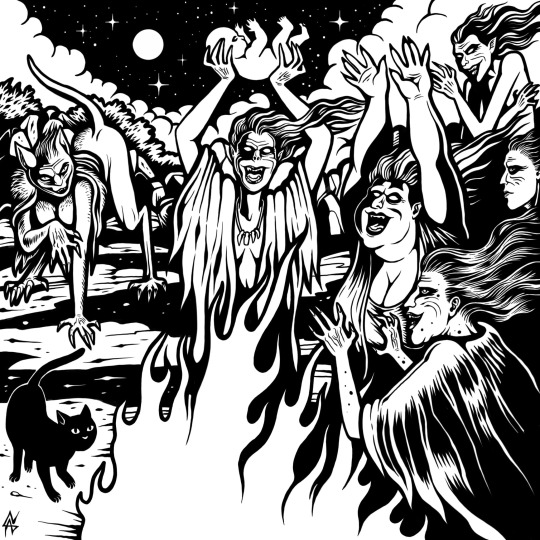
🝍 𝕴𝖙𝖆𝖑𝖎𝖆𝖓 𝕱𝖔𝖑𝖐𝖑𝖔𝖗𝖊 🝍
COGAS or BRUXAS
In the folklore of central-southern Sardinia, the witches were called Cogas or Bruxas.
Those women sneaked into the houses where there were babies (mainly male) to kill them or use them in their rituals. To avoid this eventuality, the parents would place a blessed rosary in the baby's cradle. When these dark creatures arrived at the cradle, they would be mesmerized by the rosary and lose time to count all the pearls until dawn. Being the sun one of the greatest enemies of the Cogas, they would have to escape before sunrise without being able to kidnap the baby.
It was known that the seventh daughter of a family with only female children would become a Coga, and she would be born with a little animal tail. Cogas were also shapeshifters, they could transforms themselves into animals, plants and other humans.
The figure of the Cogas can be associated with Lilith, an ancient Sumerian deity, that for Jewish culture is a female demon who can harm male newborns in the period before circumcision. Traditionally, in fact, to protect them from the demon, an amulet was placed around the neck of babies. It is also said that in order to deceive Lilith, they do not cut a child's hair until a certain age to make the demon believe that it is a girl. It seems that for the same reason in Sardinia, but also in other regions, boys' hair was not cut off before they have completed their first year of life.
23 notes
·
View notes
Photo

🝍 𝕴𝖙𝖆𝖑𝖎𝖆𝖓 𝕱𝖔𝖑𝖐𝖑𝖔𝖗𝖊 🝍
STREGO
The Strego (Witcher) is a character of the folkloric tradition of Garfagnana, Lucchesia and Versilia. Unlike classic witches and sorcerers, that used to practice various witchcraft actions towards the local population, the Strego seems to have a more ambiguous attitude as it usually takes no interest in other human beings preferring to gather in groups to carry out unidentified ceremonies. However, also traditional witches often appear in stories about Stregos.
It is supposed that the Strego is the last relic of a shamanic tradition of Eurasian origin dating back to the Paleolithic, and it's similar to the Benandanti tradition.
In the tales, covens of Stregos often congregate on the walnut trees where they sometimes scream and dance. Generally invisible, they sometimes appear identifiable by the candles they sometimes carry. They don't bother humans except for the noise they occasionally produce or their sudden appearances.
8 notes
·
View notes
Photo
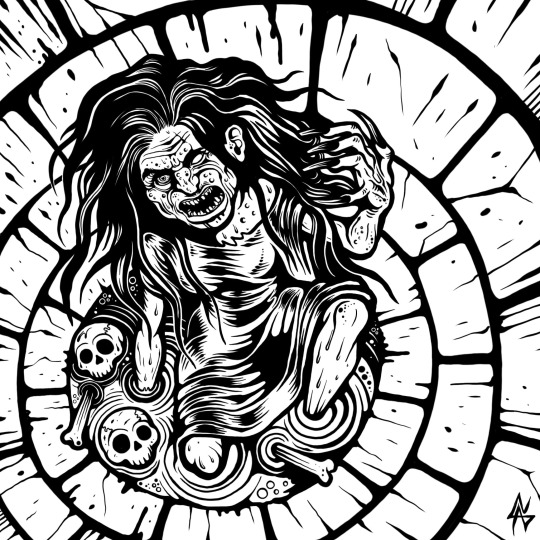
🝍 𝕴𝖙𝖆𝖑𝖎𝖆𝖓 𝕱𝖔𝖑𝖐𝖑𝖔𝖗𝖊 🝍
PETTANEDDA
Pettenedda has always been imagined as a very old woman who spends her life combing her hair (hence her name) with her very long nails, a lock of tousled hair without ever being able to put them in order, which is why it is always said to be very angry.
Sardinian mothers, to explain to children the normal noises that are heard at the bottom of a well, caused by flowing water, invented this character, and told the children that they should never go near that well and above all they should not lean out, because Pettenedda would grab them with its horrible claws and would drag them to the bottom of the well, making them his slaves for eternity.
4 notes
·
View notes
Photo

🝍 𝕴𝖙𝖆𝖑𝖎𝖆𝖓 𝕱𝖔𝖑𝖐𝖑𝖔𝖗𝖊 🝍
STREGA ENORMISSIMAGentile Budrioli, born in a respectable family and married to the notary Cimieri, was one of the most promising students of Scipione Manfredi, a famous Professor of Astrology of the University of Bologna, and learned the secrets of herbs from the Franciscan friar Silvestro. She went down in history as "Strega Enormissima" (Great Witch).She was admired and esteemed by everyone: the members of the most renowned families of the city turned to her for medications and she became friends with Ginevra Sforza, wife of the lord of the city Giovanni II Bentivoglio, who chose her as a counselor. She was the victim of envy and, after horrible torture, she was burnt at the stake in 1498. The fortified gateway is still there. According to the story, Ginevra hid here, while Gentile was burnt in Piazza San Domenico.
6 notes
·
View notes
Photo

🝍 𝕴𝖙𝖆𝖑𝖎𝖆𝖓 𝕱𝖔𝖑𝖐𝖑𝖔𝖗𝖊 🝍
ORCOLATThe Orcolat (that means "ogre" in the Friulan dialect) is a monstrous being that the folkloric tradition indicates as the cause of the earthquakes in Friuli.The ogre would live locked up in the mountains of Carnia and his every sudden movement would cause an earthquake.After 1976 it became synonymous with the earthquake that hit Friuli in that year.
7 notes
·
View notes
Photo
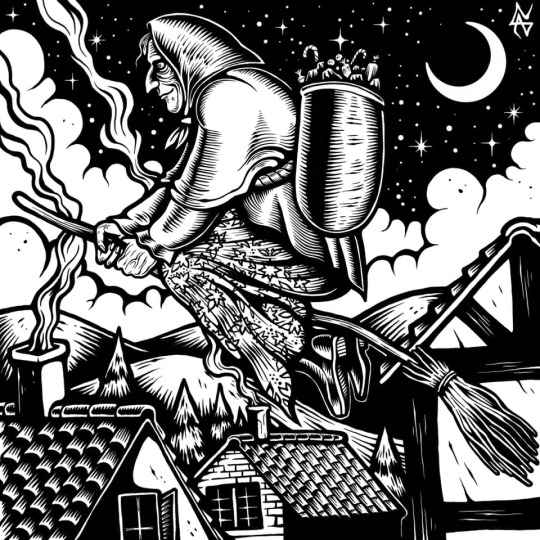
🝍 𝕴𝖙𝖆𝖑𝖎𝖆𝖓 𝕱𝖔𝖑𝖐𝖑𝖔𝖗𝖊 🝍
BEFANA
In Italian folklore, Befana is an old woman who delivers gifts to children throughout Italy on Epiphany Eve (the night of January 5) in a similar way to Santa Claus or the Three Magi Kings.A popular belief is that her name derives from the Feast of Epiphan. Epifania is a Latin word with Greek origins meaning "manifestation" (of the divinity). Some suggest that Befana is descended from the Sabine/Roman goddess named Strenia.In popular folklore, Befana visits all the children of Italy on the eve of the Feast of the Epiphany to fill their socks with candy and presents if they are good, or a lump of coal or dark candy if they are bad. In many poorer parts of Italy and in particular rural Sicily, a stick in a stocking was placed instead of coal. Being a good housekeeper, many say she will sweep the floor before she leaves. To some the sweeping meant the sweeping away of the problems of the year. The child's family typically leaves a small glass of wine and a plate with a few morsels of food, often regional or local, for the Befana.She is usually portrayed as a hag riding a broomstick through the air wearing a black shawl and is covered in soot because she enters the children's houses through the chimney. She is often smiling and carries a bag or hamper filled with candy, gifts, or both.
9 notes
·
View notes
Photo

🝍 𝕴𝖙𝖆𝖑𝖎𝖆𝖓 𝕱𝖔𝖑𝖐𝖑𝖔𝖗𝖊 🝍
UOMO NERONinna nanna, ninna oh,questo bimbo a chi lo do?Lo darò alla Befana che lo tiene una settimana.Lo darò all'Uomo Nero che lo tiene un anno intero.Lo darò all'Uomo Bianco che lo tiene finché è stanco.Lo darò al Saggio Folletto che lo renda Uomo perfetto!Lullaby, lullaby oh,Who do I give this baby to?I'll give it to the Befana who keeps it for a week.I'll give it to the Black Man who keeps it for a whole year.I'll give it to the White Man who holds it until he's tired.I will give it to the Wise Elf to make him a perfect Man!The Uomo Nero (Black Man) is a demon or a spirit, he has the appearance of a man or a ghost but black, in some regions, such as the Aosta Valley, he has no legs and from the waist down it fades into a tip. However, it also manifests itself in other forms based on how he wants to capture his victim. Until the twentieth century the figure of him was mentioned to children who did not want to sleep in the evening; in fact, they were threatened to call the black man if they didn't close their eyes and fall asleep as their relatives wanted. Like most dark creatures, linked to darkness, the black man fears the light to which he is vulnerable and cannot access the places where it reigns, children often have the habit of keeping a light on in the room when they are asleep. to keep it away until daylight comes.The black man, often identified with the figure of the Babau, is a legendary creature, an amorphous, evil and dark being present in the tradition of various countries. In Russia he is known as Buka, in Hungary he is known as Mumus or Bubus, in the German area as Butzemann, in the United States of America he is known as Boogeyman. In Spanish-speaking countries this figure is known as El Coco. In French-speaking countries he is instead known as a croquemitaine.
5 notes
·
View notes
Photo

🝍 𝕴𝖙𝖆𝖑𝖎𝖆𝖓 𝕱𝖔𝖑𝖐𝖑𝖔𝖗𝖊 🝍
BORDA
«Ninàn, ninàn, la Bordala liga i bei babèn cun una côrda.Cun una côrda e cun una curdella,la liga i bei babèn pu la i asserra,cun una côrda e cun una ligazza,la liga i bei babèn pu la i amazza»“Lullaby, the Bordashe ties the beautiful children with a rope.With a rope and a string,she ties the beautiful children and then squeezes them,with a rope and a tie,she ties the beautiful children and then kills them. "La Borda is a legendary creature that belongs to the tradition of Emilia-Romagna and other areas of the Po Valley.It is a kind of witch who appears, blindfolded and horrible, in the darker hours and on foggy days and kills anyone who has the misfortune to meet her. She is a personification of the fear related to swampy areas, ponds and canals, invoked by adults to scare children and keep them away from these dangerous places.
6 notes
·
View notes